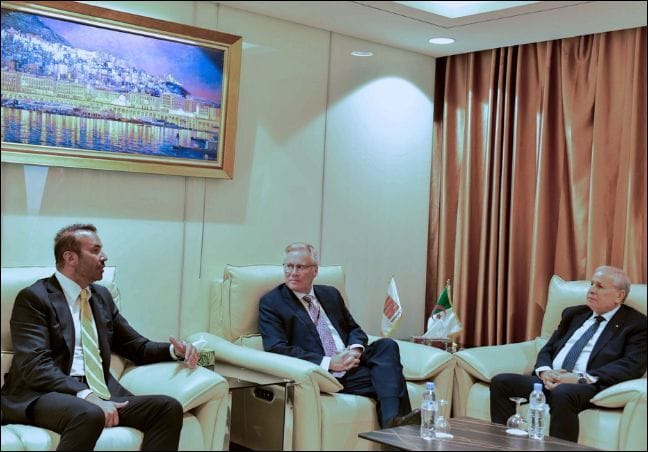- Hydrogen Rising
- Posts
- Africa’s hydrogen focus shifts to steel industry
Africa’s hydrogen focus shifts to steel industry

From the newsletter
The North African nation of Algeria is set to sign a deal with US-based Hecate Renewable Energy and steel producer Tosyali Algerie to develop an integrated green hydrogen project. The initiative aims to produce green steel, support industrial decarbonization, and advance the country’s broader energy transition goals.
Africa’s steel sector is growing thanks to infrastructure construction, making early green hydrogen adoption valuable to avoid carbon lock-ins and ensure sustainable industrial development.
Algeria’s effort aligns with broader continental initiatives to decarbonise heavy industries and promote sustainable development by integrating green hydrogen into steel production.
More details
The Algeria deal will be signed between its national oil company Sonatrach, the state-owned utility Sonelgaz, US-based Hecate Energy and steelmaker Tosyali Algerie to enable the implementation of the integrated green hydrogen project.
The integrated green hydrogen project will be carried out in two phases. The first phase, funded by the European Union and Germany’s Federal Ministry for Economic Cooperation and Development (BMZ), involves feasibility and profitability studies estimated at $32 million.The second phase will focus on construction, aimed at advancing Algeria’s energy transition goals.
Africa’s steel sector is a cornerstone of the continent’s industrial growth, underpinning infrastructure development and economic expansion. As urbanisation accelerates and countries aim to build roads, railways, housing and manufacturing facilities, demand for steel is projected to rise substantially in the coming decades.
However, steel production remains one of the most energy-intensive industrial processes globally, traditionally reliant on fossil fuels like coal and natural gas, which emit significant amounts of carbon dioxide (CO₂). This makes the sector a major contributor to greenhouse gas emissions, presenting a critical challenge for African countries striving to balance industrial growth with climate commitments.
For Africa, where industrial infrastructure is still expanding, this risk is especially acute. Without early adoption of low-carbon alternatives, the continent’s steel sector could become locked into outdated, polluting technologies, making future decarbonisation efforts costlier and more difficult.
Green hydrogen offers a transformative solution by replacing coal in the process of converting iron ore into direct reduced iron (DRI), a key step in steelmaking. This allows for the production of green steel with far fewer carbon emissions than traditional methods. Given Africa’s abundant renewable potential, green hydrogen provides a promising pathway to decarbonise the steel sector while advancing broader energy transition goals.
This initiative by Algeria exemplifies the continent’s growing commitment to hydrogen-enabled steel production. Other African nations are advancing similar initiatives with South Africa, the continent’s largest steel producer piloting projects that integrate green hydrogen into steelmaking.
In neighboring Namibia, Africa’s first green iron plant, the HyIron Oshivela project, reached a key milestone in March with the successful production of its first green hydrogen. The hydrogen will be used to produce direct reduced iron (DRI), targeting an output of 0.1 million tonnes per annum (mtpa). DRI, when combined with renewable-powered electric arc furnaces, enables the production of green steel with significantly lower carbon emissions.
Morocco is integrating green hydrogen into its wider industrial development strategy, aiming to decarbonise key sectors. As part of this, feasibility studies are underway for green steel production, one of the priority outputs in a $32.5 billion March agreement covering six new hydrogen projects.
Meanwhile, Mauritania aims to produce 12.5 million tonnes of green hydrogen annually by 2035 and capture 1% of the global green steel market by 2050. To support this ambition, state-owned mining company SNIM has partnered with CWP Global on Project AMAN, a large-scale initiative that will use green hydrogen to convert iron ore into green Hot Briquetted Iron (HBI) for export, primarily targeting European steelmakers seeking low-carbon raw materials.
These initiatives reflect a broader continental awareness that heavy industries like steel must transition towards cleaner production methods to meet national and international climate targets, such as those set under the Paris Agreement.
Despite promising developments, Africa’s transition to green steel faces significant challenges. High upfront costs, limited technical expertise and underdeveloped renewable energy infrastructure can hinder rapid deployment. Access to financing remains a major barrier, particularly for emerging economies with competing development priorities.
However, Africa’s renewable energy potential, among the highest globally, provides a strategic advantage. International cooperation, capacity building and innovative financing models, such as performance-based loans seen in recent hydrogen projects, can help accelerate the shift to a cleaner, more competitive steel industry.
Our take
With its steel sector still developing, the continent has a chance to leapfrog polluting methods. Delayed action risks embedding outdated, fossil-heavy infrastructure—making future decarbonisation slower and more expensive.
By aligning steel production with renewable energy growth, African countries are positioning themselves to first decarbonise their own industries and later become suppliers of low-carbon industrial inputs to global markets, especially in Europe.
Africa cannot develop a green steel industry in isolation. Strong partnerships with investors, technology providers and policymakers—both locally and globally—are crucial. Countries that cultivate these alliances will lead the transition.